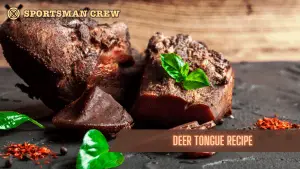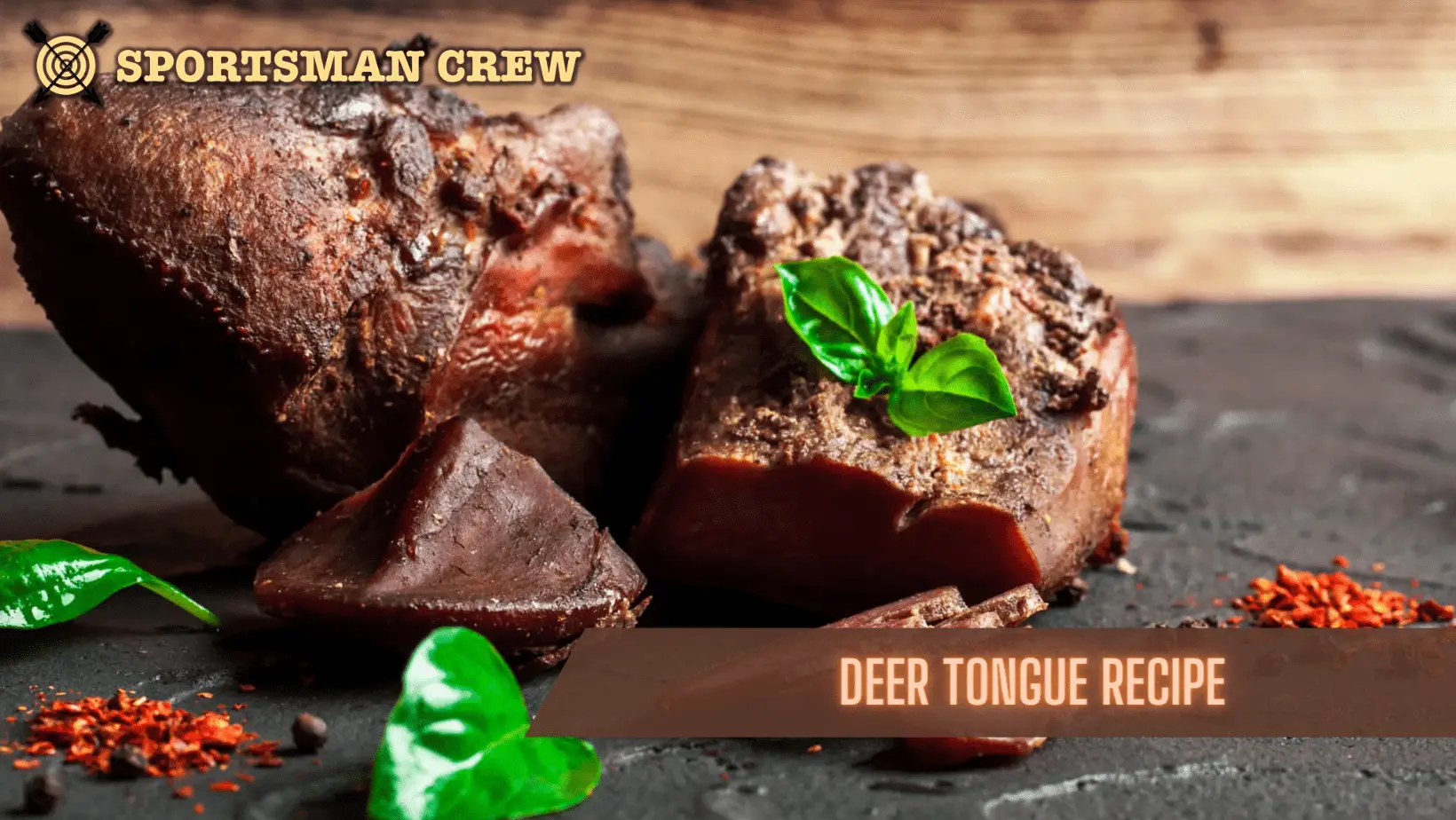Deer tongue is a popular, flavorful cut of wild game that has been used in traditional dishes for centuries. This deer tongue recipe is really unique. With its succulent texture and intense flavor, deer tongue has become a favorite amongst those who enjoy hunting and outdoor cooking.
This article will explore the history, preparation, and unique characteristics of deer tongue, as well as provide tips on how to prepare it so that it can be enjoyed at its best. If you’re interested in other deer recipes, try our recipe for deer stew in the crock pot.
Table of Contents
The Deer Tongue Recipe
If you are missing any of the ingredients, Amazon is a great place to pick them up.
1 Incredible Deer Tongue Recipe

Deer tongue is a popular, flavorful cut of wild game that has been used in traditional dishes for centuries. This deer tongue recipe is really unique. With its succulent texture and intense flavor, deer tongue has become a favorite amongst those who enjoy hunting and outdoor cooking.
Type: dish
Cuisine: venison
Keywords: deer, venison, tongue
Recipe Yield: 1
Preparation Time: PT0H10M
Cooking Time: PT3H00M
Total Time: PT3H10M
Recipe Ingredients:
- 1 Deer Tongue
- 2 quarts water
- 1 cup white vinegar
- 1 teaspoon salt
- 1 cup chopped onion
- 2 cloves minced garlic
- 1 bay leaf
- 1 teaspoon black peppercorns
Recipe Instructions: Place the deer tongue in a large pot and cover with the water. Add the vinegar and salt, and bring to a boil. Reduce heat and simmer for 1 hour. Add the onion, garlic, peppercorns, and bay leaf. Simmer for an additional 2 hours, or until the tongue is tender. Remove the tongue from the pot and allow to cool. Peel the skin off. Slice the tongue and serve with your favorite condiments.
4
What Does Deer Tongue Taste Like?
Deer tongue has a mild gamey flavor and is often compared to liver. The texture is similar to that of beef tongue, but it’s more tender and contains more collagen. It can be cooked in various ways, including braising, sautéing, grilling, and roasting.
Beneficial Uses of Deer Tongue
Deer tongue has been used for centuries by Native Americans, as well as in Chinese, Japanese, and other traditional medicines. It has a range of purported health benefits, including antibacterial, anti-inflammatory, and analgesic (pain relieving) properties. It is also thought to boost the immune system, reduce stress, and help with digestion.
In traditional Chinese medicine, deer tongue is used to treat a variety of conditions, including respiratory issues and joint pain. It is also believed to have detoxifying effects, as well as being beneficial for skin health. In addition, it is thought to help with improving appetite, strengthening the bones, and treating burns, ulcers, and urinary tract infections.
Deer tongue is also used to make a variety of herbal remedies and concoctions. It is believed to be a natural way to reduce high cholesterol, hypertension, and even cancer. The herb has also been used to treat colds and the flu, as well as to reduce fatigue.
The most common way to consume deer tongue is by making a tea, which can be sweetened with honey or another natural sweetener. You can also make a tincture or extract by boiling the herb in water and then straining it. Deer tongue can also be taken in capsule form or as an oil.
As with any natural remedy, it’s important to consult a doctor before using deer tongue, as the herb may interact with certain medications. It’s also a good idea to start with a small dose and increase it gradually. Deer tongue should not be taken by pregnant women or those with certain medical conditions, such as kidney or liver disease.
Overall, deer tongue has a long history of use in traditional medicines and is believed to have a variety of health benefits. It can be taken in a variety of forms, but it’s important to speak with a doctor before consuming it in any form.
Is Eating Deer Tongue Good for You?
When it comes to deciding whether or not to add deer tongue to your diet, there are a few things to consider. Deer tongue, like many other wild game meats, can be a great source of lean protein and healthy fats. It has a strong, gamey flavor that is unique to wild game meats. A good deer tongue recipe will mask the gamey flavor a bit but still give you the full experience of eating deer tongue.
In addition to being a potentially healthy food source, deer tongue also has a long history of being a delicacy in many cultures. It is considered a treat in some countries and is a popular item in many restaurants. In fact, it’s been described by some as one of the most delicious meats available.
However, it’s important to be aware of the potential risks associated with eating deer tongue. The meat can contain high levels of mercury, which can be harmful to humans. It can also contain parasites, which may cause illness if not cooked properly. For this reason, it’s important to purchase deer tongue from a reliable source and to cook it thoroughly.
Ultimately, the decision to eat deer tongue must be made on an individual basis. For those who enjoy the unique flavor and are willing to take the necessary precautions, deer tongue can be a great addition to a healthy diet.
How to Preserve and Store Deer Tongue
Deer tongue is a delicacy enjoyed by many, but can be difficult to store and preserve. If you are lucky enough to have harvested some of this tasty treat, here are some tips for storing and preserving it.
First, make sure you process the deer tongue as soon as possible after the kill. Immediately after harvesting, the tongue should be skinned, cleaned, and can be frozen or cured.
If you are freezing the tongue, make sure you wrap it in plastic wrap or aluminum foil and store it in a freezer safe container. This will help it keep its texture and flavor. If you are curing the tongue, you can use a salt cure or a sugar cure. Salt cures are the most common, and involve covering the tongue in a mixture of equal parts salt and sugar, and rubbing it in to the surface.
Once the curing process is complete, the tongue should be hung in a cool, dry place for a few weeks. This allows the preservative to penetrate the tongue and will help preserve it.
Finally, the deer tongue should be wrapped in cheesecloth and placed in an airtight container. This will help keep it moist and prevent it from drying out. This is only necessary if you are going to save the deer tongue and use the deer tongue recipe later.
Final Thoughts on Deer Tongue
Deer tongue is a unique and often overlooked ingredient in many dishes. When cooked correctly, it can have a tender and juicy texture that is unlike any other meat. The taste is mild and slightly sweet, and can be a great addition to stews, sandwiches, and even tacos.
There are a few things to consider when preparing deer tongue. First, you need a good deer tongue recipe. The most important is the timing. If cooked too long, it can become tough and chewy. If cooked too little, it can be too soft and mushy. It is best to cook it over low to medium heat and just to the point of being tender.
Once cooked, deer tongue can be served in a variety of ways. It can be sliced and served with a salad or cooked in a stew with vegetables. It can also be used in tacos or sandwiches, as a taco filler or as a topping for a burger.
When it comes to marinating, deer tongue is best with a light marinade of olive oil and herbs. A classic combination is rosemary and thyme, or you can use a combination of your favorite herbs. You can also add a little bit of garlic or some lemon juice for a more complex flavor. This is why our deer tongue recipe contains garlic.
Deer tongue is a great ingredient to have in your pantry and can add a unique flavor to your cooking. Its mild and slightly sweet taste adds a new dimension to many dishes, and with a little creativity, it can be transformed into something truly delicious.
